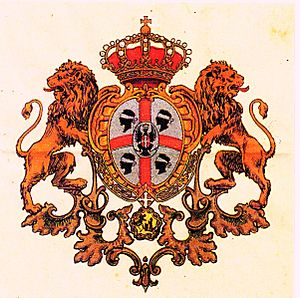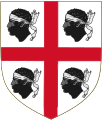Kingdom of Sardinia (1324–1720) facts for kids
Quick facts for kids
Kingdom of Sardinia
|
|||||||||||||||
|---|---|---|---|---|---|---|---|---|---|---|---|---|---|---|---|
| 1324–1847 | |||||||||||||||
|
|
|||||||||||||||
|
Anthem:
S'hymnu sardu nationale
"The Sardinian national anthem" |
|||||||||||||||
| Status |
|
||||||||||||||
| Capital | |||||||||||||||
| Common languages | Sardinian, Corsican, Catalan and Spanish | ||||||||||||||
| Religion | Roman Catholicism (official) | ||||||||||||||
| Demonym(s) | Sardinian | ||||||||||||||
| Government | |||||||||||||||
| King | |||||||||||||||
|
• 1324–1327 (first)
|
James II | ||||||||||||||
|
• 1720 (last before the Savoy rule)
|
Charles VI, Holy Roman Emperor | ||||||||||||||
| Historical era | Middle ages, Early modern, Late modern | ||||||||||||||
| 1297 | |||||||||||||||
| 1324 | |||||||||||||||
| 1708 | |||||||||||||||
| 1717 | |||||||||||||||
| 1720 | |||||||||||||||
|
• Perfect fusion with Piedmont
|
1847 | ||||||||||||||
| Currency |
|
||||||||||||||
|
|||||||||||||||
| Today part of | Italy | ||||||||||||||
The Kingdom of Sardinia was a historical state in Southern Europe. It began in the early 14th century. This kingdom was first controlled by the Crown of Aragon and later by the Spanish Empire.
The kingdom included the island of Sardinia and a claim to Corsica. The Pope claimed control over both islands. In 1297, the Pope gave these islands as a special gift, called a fief, to King James II of Aragon. This gift was known as the "Kingdom of Sardinia and Corsica."
Starting in 1324, James II and his followers began to conquer Sardinia. They slowly took control of the island. By 1420, they had full power over Sardinia. After the crowns of Aragon and Castile joined, Sardinia became part of the growing Spanish Empire.
In 1720, the island was given to the Duke of Savoy, Victor Amadeus II of Savoy. This happened after a big war involving different royal families. Sardinia kept its own rules and systems until 1847. At that time, King Charles Albert of Savoy made changes to unite Sardinia more closely with the mainland Savoyard state.
Contents
Sardinia's Early History
Sardinia became a Roman province in 238 BC, along with Corsica. The Romans ruled the island until the mid-5th century. Then, a group called the Vandals took control. In 534 AD, the Byzantine Empire (Eastern Roman Empire) reconquered it.
Sardinia remained a Byzantine province until the 9th century. After this, it became hard to communicate with the Byzantine capital, Constantinople. Strong local families on the island then took charge.
From 705 AD, Saracens from North Africa attacked coastal cities. Sardinia had little outside help against these attacks. So, the island organized itself like the old Roman and Byzantine systems. It was seen as a separate entity, not just the ruler's personal property.
Information about Sardinia's political situation in the next centuries is limited. Because of Saracen attacks, many coastal cities were abandoned. For example, Tharros was left for Oristano in the 9th century. Caralis and Porto Torres also suffered.
In 1015–16, a large Saracen attack from the Balearics was stopped. The local Sardinian rulers, called Judicates, fought them off. They had help from the fleets of Pisa and Genoa.
After a major split in the Christian church, Rome wanted to bring Sardinia closer to Western traditions. The island had been influenced by Byzantine culture. The local rulers, called "Judges," had a Byzantine title.
Before the Kingdom of Sardinia and Corsica, the island was ruled by "archons" or "judices." These leaders were like kings of all Sardinia. They were technically under the Byzantine emperors. Two known names are Turcoturiu and Salusiu from the 10th century.
The island was later divided into four small kingdoms. These were the Judicates of Cagliari, Arborea, Gallura, and Logudoro. They were well-organized but influenced by the Pope. The Pope claimed power over the island.
Italian cities like Genoa and Pisa also had influence. Genoa was mostly in the north and west. Pisa was mostly in the south and east. This led to conflicts among the Judges. They saw themselves as kings fighting against rebellious nobles.
Later, the title of King of Sardinia was given to Barisone II of Arborea and Enzio of Sardinia. Barisone tried to unite the island but failed. Enzio was given the title by his father, Frederick II, Holy Roman Emperor. But he was soon called away and died in prison.
The Kingdom of Sardinia and Corsica was a state whose king was the King of Aragon. Aragon began conquering it in 1324. They gained full control in 1410. The king ruled directly until 1460.
In 1460, the kingdom became part of the Crown of Aragon. This was a group of states with their own rules, united under one king. The idea for the kingdom came from Pope Boniface VIII in 1297. He wanted to help James II of Aragon gain control of Sicily.
The Pope offered Sardinia and Corsica to James II. At that time, other states controlled these islands. Pisa and Genoa had influence in Sardinia. Genoa had also ruled Corsica for about 200 years.
This papal decision was also a victory against Pisa and the Holy Roman Empire. Sardinia was under the control of the Catholic kings of Aragon. The Sardinian church had always been loyal to Rome.
How the Kingdom of Sardinia Began
In 1297, Pope Boniface VIII created the idea of a "Kingdom of Sardinia and Corsica." He said it would be a fief (a land granted by a lord) of the Pope. The Pope then offered this new kingdom to James II of Aragon. He promised James support if he conquered Sardinia from Pisa.
In 1323, James II teamed up with Hugh II of Arborea. After a military campaign, they took over the Pisan areas of Cagliari and Gallura. They also captured the city of Sassari. James II then claimed this land as the "Kingdom of Sardinia and Corsica."
In 1353, the Judicate of Arborea went to war with Aragon. Aragon did not fully conquer the last native Sardinian kingdom until 1420. The Kingdom of Sardinia and Corsica kept its own identity within the Crown of Aragon. It was not just absorbed into the Kingdom of Aragon.
During his struggles with Arborea, Peter IV of Aragon gave the kingdom its own laws. A viceroy governed the kingdom in the king's name.
In 1420, Alfonso V of Aragon bought the remaining parts of the Judicate of Arborea. He paid 100,000 gold coins to the last judge, William III of Narbonne. This meant the "Kingdom of Sardinia" now covered almost the entire island. Only the city of Castelsardo was left. It was taken from the Doria family in 1448.
Corsica was never fully conquered by Aragon. So, it was removed from the kingdom's official name. Sardinia then became part of a united Spain. The defeat of local kingdoms and the new Spanish rule led to a decline in Sardinia.
There was a short period of revolts led by Leonardo Alagon. He fought against the viceroy in the 1470s. But his forces were crushed in the Battle of Macomer in 1478. This ended major revolts. Attacks from North African pirates and outbreaks of plague also made things worse.
Aragon Conquers Sardinia
The Kingdom of Sardinia and Corsica officially started in 1297. But it truly began in 1324. That year, James II helped his allies from the Judicate of Arborea in a war against Pisa. He took over Pisan lands in Cagliari and Gallura.
In 1347, Aragon fought against the Doria and Malaspina families. These families were from Genoa and controlled much of northwest Sardinia. Aragon added these lands, including Alghero and Sassari, to its direct control.
The Judicate of Arborea was the only Sardinian state still independent. It was much harder to conquer. In 1353, Arborea, led by Marianus IV of Arborea, began to conquer the rest of Sardinia. By 1368, Arborea had almost driven the Aragonese from the island. The "Kingdom of Sardinia and Corsica" was reduced to just the port cities of Cagliari and Alghero.
A peace treaty in 1388 returned some lands to Aragon. But tensions continued. In 1382, the Arborean army, led by Brancaleone Doria, again took control of most of the island. This lasted until 1409. The Arborean army suffered a big defeat by the Aragonese in the Battle of Sanluri.
After 1420, the remaining Arborean lands were sold to Aragon. The "Kingdom of Sardinia" then covered almost the entire island. Only Castelsardo was taken later in 1448. Since Corsica was never taken from Genoa, it was removed from the kingdom's name.
In 1527, a French army attacked northern Sardinia. They besieged Castellaragonese and sacked Sorso and Sassari.
In 1566, the first printing press was set up in Cagliari. Universities were founded in Cagliari (1607) and Sassari (1617).
In the late 15th and early 16th centuries, the Spanish built watchtowers along the coast. These "Spanish towers" protected the island from Ottoman attacks. In 1637, a French fleet sacked Oristano for about a week.
Sardinia Changes Hands
Spanish rule over Sardinia ended in the early 18th century. This was due to the War of the Spanish succession. In 1713, the Treaty of Utrecht divided Spain's European lands. The House of Savoy received Sicily. Charles VI, Holy Roman Emperor received Sardinia and other territories.
During another war, the War of the Quadruple Alliance, Victor Amadeus II of Savoy had to give Sicily to the Austrians. In return, he received Sardinia. This exchange was made official in the Treaty of The Hague (1720) on February 17, 1720. Because the Kingdom of Sardinia had existed for a long time, Victor Amadeus could keep his title of king.
Victor Amadeus did not like this exchange at first. Until 1723, he still called himself King of Sicily. The state's official name became "Kingdom of Sardinia, Cyprus and Jerusalem." This was because the House of Savoy still claimed the thrones of Cyprus and Jerusalem. However, both had been under Ottoman rule for a long time.
In 1847, the local Sardinian government was changed. The Viceroy and other institutions were removed. However, the House of Savoy kept the title of King of Sardinia. They held this title until they lost the Italian throne in 1946.
Flags, Royal Standards and Coats of Arms
- Coats of arms
-
Middle Ages
(union with Aragon)
- State Flags
Maps
Territorial Changes of Sardinia (1324-1720)
-
The Kingdom of Sardinia from 1410 to 1420. This was after the defeat of the Arborean Judicate in the Battle of Sanluri (1409).
See also
 In Spanish: Reino de Cerdeña (1324-1720) para niños
In Spanish: Reino de Cerdeña (1324-1720) para niños
- List of monarchs of Sardinia
- List of viceroys of Sardinia
- Spanish Empire
- S'hymnu sardu nationale
- Kingdom of Sardinia (1700–1720)












